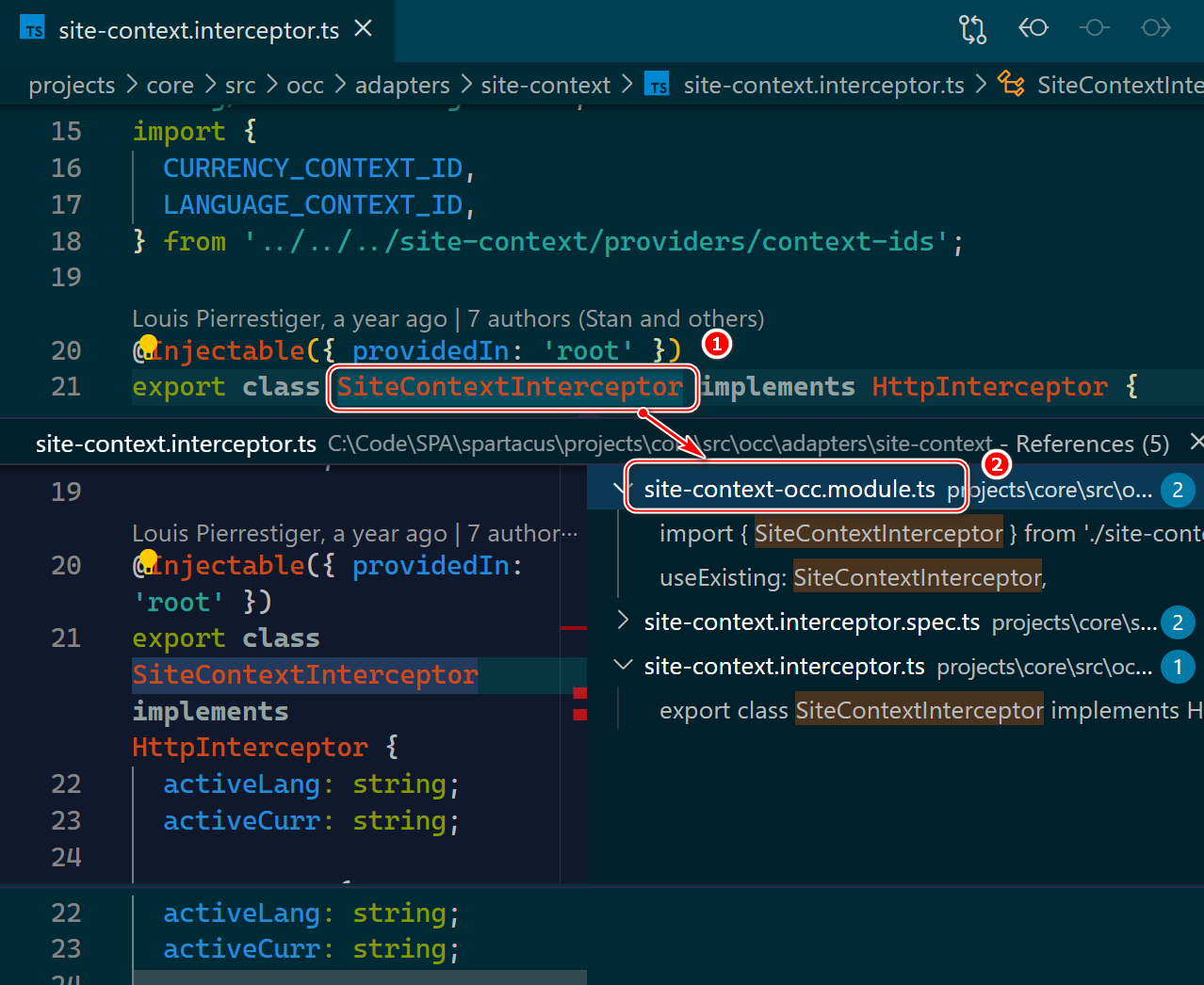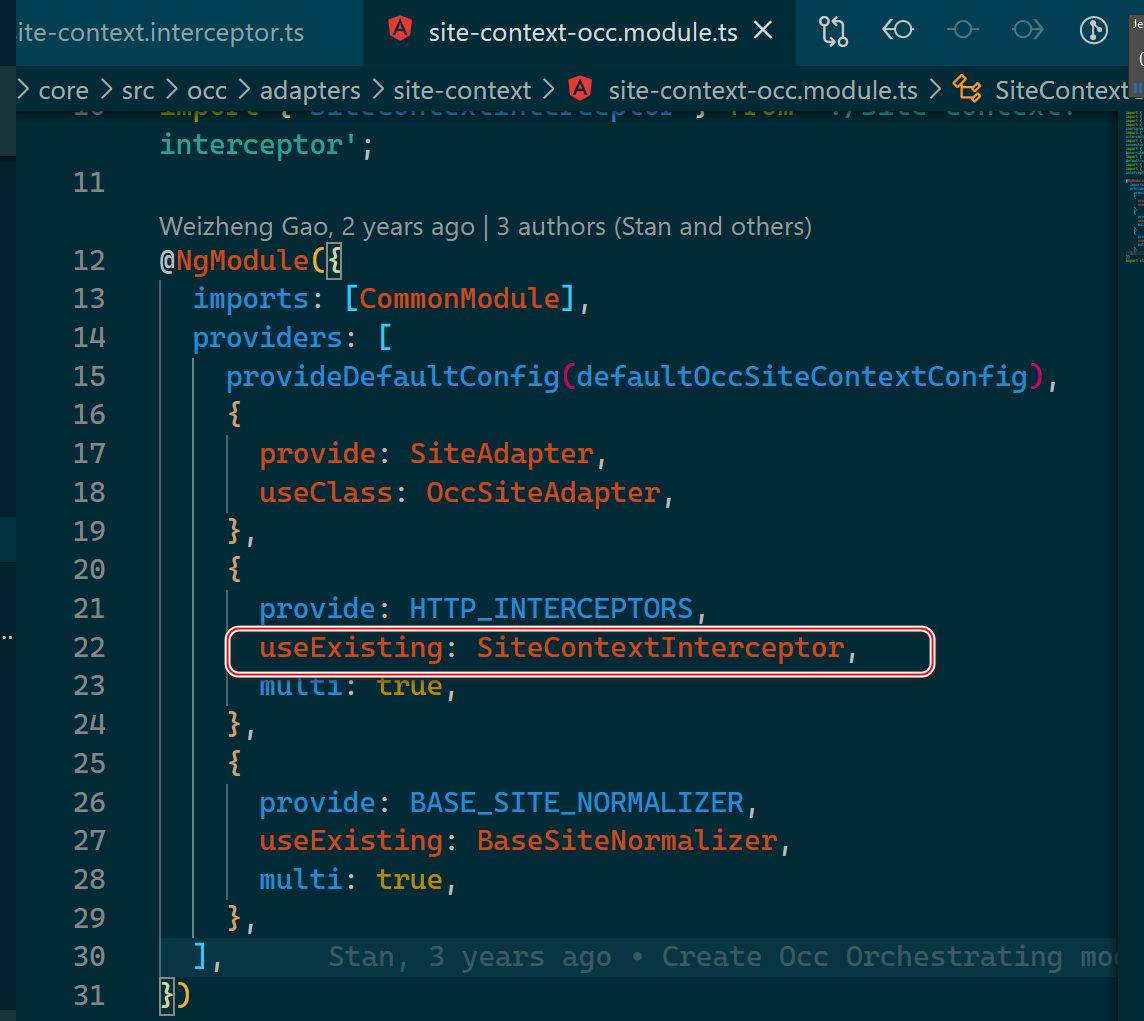SAP Spartacus HTTP Interceptor 的 provisioning 逻辑
JerryWang_汪子熙 -假import { Injectable } from '@angular/core';
import {
HttpEvent, HttpInterceptor, HttpHandler, HttpRequest
} from '@angular/common/http';
import { Observable } from 'rxjs';
/* Pass untouched request through to the next request handler. /
@Injectable()
export class NoopInterceptor implements HttpInterceptor {
intercept(req: HttpRequest<any>, next: HttpHandler):
Observable<HttpEvent<any>> {
return next.handle(req);}
}
这个 NoopInterceptor 是由 Angular 的依赖注入 (DI) 系统管理的服务。 与其他服务一样,开发人员必须先提供拦截器类(Interceptor Class),然后应用才能使用它。
由于拦截器是 HttpClient 服务的可选依赖项(`optional dependencies`),因此必须在提供 HttpClient 的同一注入器或注入器的父级中提供它们。 DI 创建 HttpClient 后提供的拦截器将被忽略。
如果应用程序在应用程序的根注入器中提供 HttpClient,作为在 AppModule 中导入 HttpClientModule 的副作用,那么也应该在 AppModule 中提供拦截器。
从 `@angular/common/http` 导入 HTTP_INTERCEPTORS 注入令牌后,按照下列形式为 NoopInterceptor 提供 provider.
{ provide: HTTP_INTERCEPTORS, useClass: NoopInterceptor, multi: true },
注意上面代码的 `multi: true` 选项。 这个设置告诉 Angular, `HTTP_INTERCEPTORS` 是一个用于注入`一组值`,而不是注入`单个值`的 `多提供者`的令牌。
考虑创建一个 `barrel index` 文件,将所有拦截器提供者的代码,收集到一个 httpInterceptorProviders 数组中。
这个 barrel index 文件的文件名为 index.ts, 内容如下:
/ "Barrel" of Http Interceptors /
import { HTTP_INTERCEPTORS } from '@angular/common/http';
import { NoopInterceptor } from './noop-interceptor';
/* Http interceptor providers in outside-in order /
export const httpInterceptorProviders = [
{ provide: HTTP_INTERCEPTORS, useClass: NoopInterceptor, multi: true },
];
然后我们在 App Module 里直接从 `index.ts` 里导入 httpInterceptorProviders 数组即可:
providers: [
httpInterceptorProviders
],
下面我们看一看 Spartacus 的 SiteContextInterceptor 是如何被导入 NgModule 的。
发现它被导入一个名为 `SiteContextOcc` 的 module 之中。

在这个 module 里,我们使用了 `useExisting` 而非 `useClass`:

useExisting 相当于 provider alias,即别名。
{provide: Class2, useExisting: Class2}
上面的代码并不会导致 Angular DI 框架主动为 Class2 创建实例。运行时如果构造函数请求 Class2 的实例,Angular DI 会为 key 为 Class2 的依赖,寻找另一个 `provider`,并从这个 Class2 提供者中取出注入实例。 开发人员可以把 `useExisting` 看成对另一个提供者或别名的引用。Tags 标签
前端javascripttypescripthtmlhtml5扩展阅读
HTML5离线存储
2020-03-06 14:13:06 []CSGO电竞API数据接口【West S2战队数据】分享使用演示
2020-09-03 07:18:05 []wamp配置局域网访问
2020-09-04 01:12:17 []接口测试工具apipost3.0版本对于流程测试和引用参数变量
2020-09-15 15:12:13 []vs code的使用与常用插件和技巧大全总结
2020-09-17 03:07:47 []没有伞的孩子 [必须] 要学会奔跑
2020-09-17 04:49:49 []学习之apipost3.0文档移动和文档管理教程
2020-09-18 06:19:35 []分享—如何使用apipost模拟手机实现请求发送
2020-09-18 12:15:00 []【分享】apipost如何使用mock测试
2020-09-19 21:59:25 []Apipost使用技巧之分享
2020-09-19 11:44:49 []加个好友,技术交流

